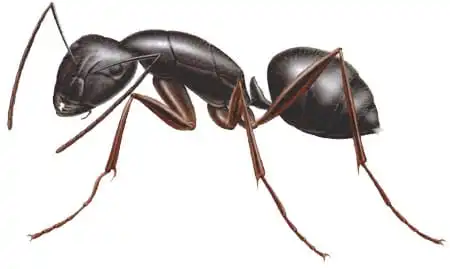Springtime in the Pacific Northwest is beautiful, with cherry blossoms and daffodils blooming. However, the warm weather also brings unwanted critters, including ants. In this article, we’ll cover:
- Identification
- Signs of an infestation
- What not to do
- How Sunrise can help
- Preventing future infestations
Identification
Carpenter Ants vary in size and color, making them challenging to identify. The most common species in Western Washington is Camponotus modoc, which is black with reddish-brown legs. Queens are about 16-18mm in length, while workers range from 6mm to 13mm.
During spring, you might spot winged carpenter ants (reproductives or swarmers), indicating a mature colony. Increased activity often occurs around March or April as the weather warms. It's not uncommon to see some activity as early as January. A few ants indoors can be expected during swarming, and if only spotted occasionally, they may not be a cause for concern.
Signs of an Infestation
- Regular sightings of ants
- Piles of sawdust or frass around your home
- Rustling noises in the walls
- Trails of workers or winged reproductives
Consistent sightings, such as seeing 2-3 ants daily, can indicate a potential infestation. Carpenter Ants travel through wall voids, so prompt action is necessary once an infestation is suspected.
Consistent Sightings
If you see a few carpenter ants, it might just be a scout. Regular sightings are a red flag. If you notice trails of ants, contact a licensed pest control expert immediately, as you may be dealing with an infestation.
Sawdust or Frass
Piles of sawdust or frass near wood structures may indicate a carpenter ant infestation. They prefer water-damaged or decaying wood but can also invade sound wood in crawl spaces or walls.
Rustling Noises
Carpenter ants create galleries in wood, producing rustling sounds, especially at night when they are most active. These noises can help you locate their activity.
Spotting Workers or Reproductives
Sighting trails of worker ants or winged reproductives suggests a larger problem. Winged reproductives are particularly indicative of a mature colony, which may have existed for 4 to 7 years.
What Not to Do
- Self-treat with DIY methods without consulting a professional
- Ignore the problem in hopes it will go away
- Attempt to identify them yourself
- Neglect preventative measures
Don’t DIY
While DIY solutions may seem cost-effective, they often fail to eliminate the entire colony. Consult a licensed pest control professional for effective treatments. Many over-the-counter solutions can create conducive conditions for other pests and may not provide a long-lasting solution.
Don’t Ignore Them
Carpenter ants don't die in winter; they remain active and can establish large colonies. Ignoring them will allow their population to grow.
Don’t Identify Them Yourself
Carpenter ants vary in color and size, making misidentification possible. Contact a professional for accurate identification and treatment.
Don’t Procrastinate Prevention
What you may initially think is a minor problem could be a satellite colony. Regular preventative services are essential, as pheromone trails can lead to recurring infestations.
How Sunrise Can Help
Sunrise Pest Management employs an Integrated Pest Management method to control carpenter ant infestations. Our technicians conduct thorough inspections in all areas, including attics and crawl spaces, to accurately assess the ant activity.
You don’t need to leave your home during treatment, as our licensed technicians use pet- and child-safe materials to target active colonies.
After treatment, you may still see activity for 1 to 2 weeks, but live ants should begin to appear sluggish, indicating that the treatment is working. Our service comes with a 60-day warranty for added peace of mind!
Are Our Products Safe?
Absolutely! We adhere to strict federal and state guidelines, and our Quality Control Department ensures proper execution of each service. We can provide Material Safety Data Sheets upon request to keep you informed and safe.
Prevention
At Sunrise Pest Management, we emphasize the importance of preventive measures to reduce the likelihood of an infestation. Our comprehensive quarterly treatment plan is highly recommended for Washington residents.
Our All Pest Protection service includes a warranty that covers various pests, including carpenter ants, ensuring your home remains protected. Learn more about how All Pest Protection can safeguard your home.



Comments (0)
Thanks for your comment!
Thanks for your feedback! Your comments have been successfully submitted! Please note, all comments require admin approval prior to display.
Error submitting comment!
There is a problem with your comment, please see below and try again.